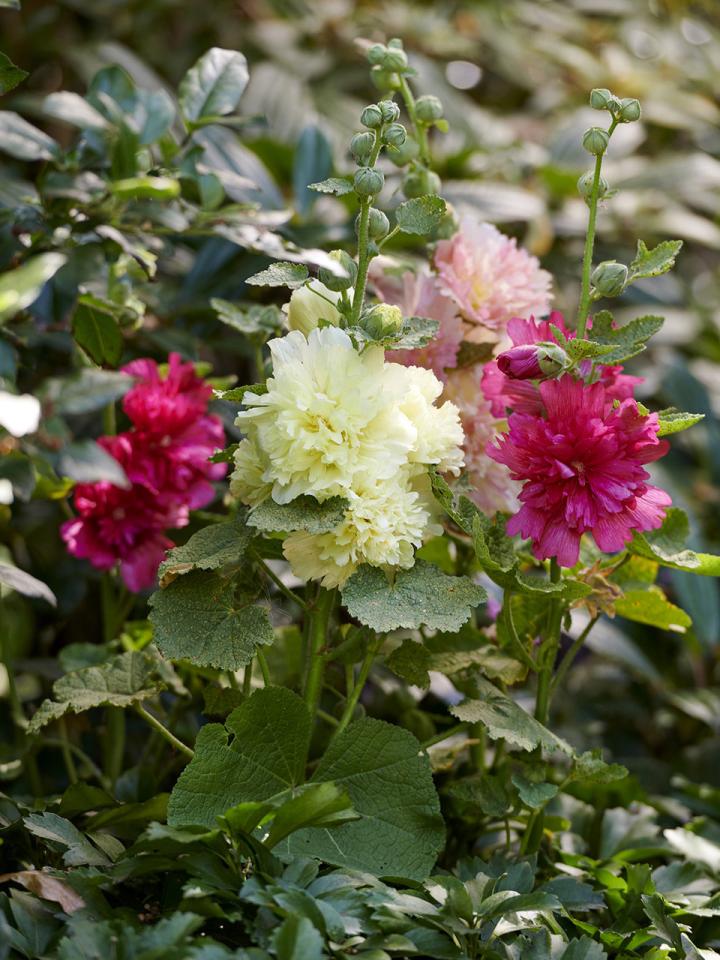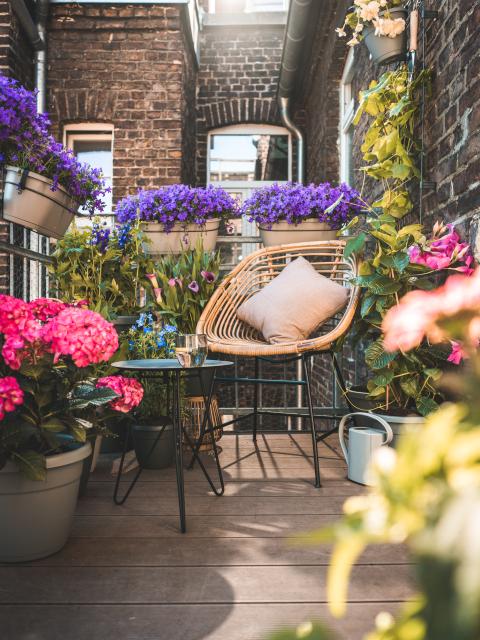HOLLYHOCK: CHARACTERISTICS AND FLOWERs
Hollyhock, or Alcea rosea, is a perennial plant and a real eye-catcher in any outdoor space. Hollyhock can be recognised by its long stems with large green leaves, which end in radiant flowers. The blooms can have a single or a double row of petals and the flowers can be white, pink, red, purple or yellow in colour. All varieties of hollyhocks attract bumblebees, bees, butterflies and other pollinators, making this plant a great choice to increase biodiversity. As the flowers are deep and large, pollinators can easily reach the nectar inside.
Hollyhocks belong to the cheesewort family (Malvaceae), which also includes plants such as cheesewort, hibiscus and cotton. The name cheesewort is derived from the shape of the fruits, which are round and resemble Gouda cheese.
Hollyhock is a true summer bloomer. It usually flowers between June and October and grows to an average height of 1.5 metres, although there are outliers that reach as high as 3 metres. Hollyhock needs relatively little space on the ground to grow, making it the perfect addition to narrow borders, tinier gardens and sheltered courtyards.
HOLLYHOCK SPECIES
There are some 60 different species of hollyhock, found in different regions around the world. As different classification methods are used it's difficult to determine exactly how many species exist, but some of the most well-known species of hollyhock are:
- Alcea rosea: this is the ‘common’ hollyhock and the most common species. Alcea rosea is widely grown for its striking flowers and attractive, upright growth habit. The flowers of this species come in a wide range of colours, such as white, pink, red, yellow and purple. This species usually grows between 1.5 and 2 metres tall.
- Alcea rugosa: this species, also called Russian hollyhock due to its origin in Russia and Ukraine, has larger flowers and sturdier stems than the common hollyhock. This species usually grows a little taller than the common hollyhock (around 2.5 metres), but does not branch out as much. Much like the Alcea rosea, the flowers of this species can have a variety of colours, ranging from pastel shades to deeper hues.
- Alcea ficifolia: this species, also known as fig-leaf hollyhock, has striking leaves resembling those on a fig tree. This species usually has flowers in soft hues, such as light shades of orange and yellow. The height of this species is similar to that of the common hollyhock.
HOLLYHOCK: SOW OR PLANT?
You can either sow hollyhocks or plant them as seedlings or small plants. Which you choose depends on your preference and how quickly you want to see results. Whatever your choice, ollyhocks are generally easy to grow, as long as you put them in the right location and care for them well.
- Are you sowing hollyhocks?
- Make sure you prepare your garden soil well and improve the quality with organic compost. Sow the seeds shallowly, about 40-50 cm apart, and cover them lightly with soil. Keep the soil nicely moist until the sprouts emerge.
- Sow hollyhocks in spring (April/May) or in early autumn (September). If you plant in spring, keep in mind that they only give leaves the first year, and will not flower yet.
- Are you planting hollyhocks? If you prefer to see fast results and don't want to wait for seeds to germinate, you can buy hollyhocks as small plants at a garden centre or nursery. These little plants are usually several months old and have already developed solid roots. You can plant hollyhocks in spring (after the frosts are over) or in late summer. To do so, check out these tips for planting garden plants.
WHERE SHOULD YOU PLANT HOLLYHOCKS AND HOW SHOULD YOU CARE FOR THEM?
Are you planning to sow or plant hollyhocks in your garden? If so, check out these tips on hollyhock care and the best locations to put your new plants.
- Hollyhock prefers a warm, sunny spot. Preferably choose a spot where the hollyhock gets at least six hours of sunlight a day, to encourage abundant flowering.
- Hollyhock likes to grow against a wall or fence that reflects the heat and protects it from strong winds. A south-facing wall or fence is ideal.
- As hollyhocks can grow tall and carry heavy flowers, they often need support (e.g. with a cane or ring support)
- Make sure the soil is well-drained and not too heavy. The soil should be moist, but not soggy, as this can cause root rot.
- Hollyhock prefers fairly poor clay soil. The darker the flowers, the sandier the soil may be.
- Give hollyhocks organic fertiliser in spring to promote growth and flowering. You can also apply a layer of compost around the plant.
- If the weather is hot and dry, water hollyhocks more often, otherwise the flowers will dry out.
- Water hollyhocks close to the ground, at the base of the plant. Do not water on the leaves! That can cause ‘rust’ marks, which are undesirable.
ORANGE OR BROWN 'RUST' SPOTS ON HOLLYHOCKS
Are you surprised to see yellow, orange or brown spots on the leaves of your hollyhock plants? This is probably 'rust', which can be caused by too little sun, too many hollyhocks too close together, a very wet period (meaning the soil is too moist) or watering the plants directly onto the leaves. Act quickly and remove all the leaves and the parts of the plant that are affected. Don't throw affected parts into your compost, but throw them away entirely instead to avoid spreading it further. Is the plant badly affected? Then use an organic pesticide to control the rust.
HOLLYHOCK: A HARDY PERENNIAL PLANT
Hollyhocks are hardy, which means they survive British winters just fine. Hollyhocks are usually biennial (or perennial) plants. In their first year of growth, they'll only grow leaves, not flowers - but by their second year growing, flowers should appear. With proper pruning, hollyhocks can flower for more than two years and treat you to their floral splendour for years to come.
WHEN AND HOW SHOULD YOU PRUNE HOLLYHOCKS?
Have your hollyhocks finished flowering? After the flowering period is over (in September or October), cut away the flower stalks. Trim to about 30 cm above the ground. Don't prune them back any further, because you then risk water getting into the stem, which can cause the plant to rot. By pruning the hollyhock after it has finished flowering, the plant puts all its energy into the rest of the plant, making it more likely to flower again next year.
HOW TO PRUNE SOWN HOLLYHOCKS
If you'd like your hollyhocks to reproduce, you can choose not to prune the stems after flowering and let them do their own thing and will self-sow. If you have too many seedlings, you can thin them out by staking them out. Hollyhock seed pods can contain seeds of a different colour to those of the mother plant, so after a while you may well see a rainbow of different coloured hollyhocks in your garden!
WHERE DOES HOLLYHOCK ORIGINALLY COME FROM?
Hollyhock has been grown and used for centuries. The first reports of hollyhock date back to ancient times, when they were valued for their ornamental and medicinal properties. Hollyhock is native to central and southwest Asia, but they were also spotted early in the Middle East, in countries such as Turkey and Palestine. Around the 16th century, the plant appeared in Europe, probably via trade routes. Over the centuries, hollyhocks were further cultivated and improved, creating more and more varieties. Today, hollyhocks are very popular both in rural settings such as on farms, and in urban settings, such as in sheltered city gardens or against the walls of houses.
HOLLYHOCK SYMBOLISM
In the plant world, hollyhocks symbolises fertility. At the end of their flowering period, when the leaves begin to droop a little, the plant forms a round ‘box’ containing seeds. These boxes fall to the ground, break open and sow their seeds there, or are taken by birds that break them open elsewhere. A special feature of the plant is that the seed capsules can also contain seeds of a different colour from those of the mother plant - another reason why hollyhock stands for fertility.
HOLLYHOCK: EDIBLE OR POISONOUS?
Hollyhocks are not poisonous to humans, nor are they toxic to cats, dogs and other domestic animals. In fact, the flowers and leaves are sometimes eaten. The flowers have a mild, nutty flavour and can be used in salads or as a garnish. Hollyhock flowers can also be used to make tea and young leaves can be cooked and eaten like spinach. Be careful of the quantities you're eating, as large amounts can have a laxative effect. It's important to never sink your teeth into any old cut flower or plant: only consume cut flowers and plants that have not been treated with pesticides or other chemicals and have been grown with the intention of being eaten.






